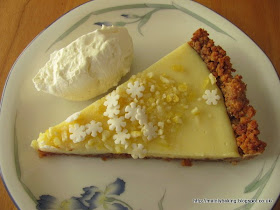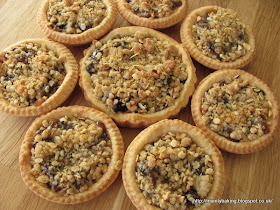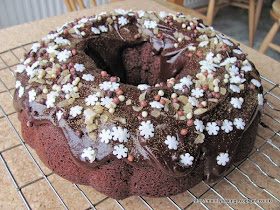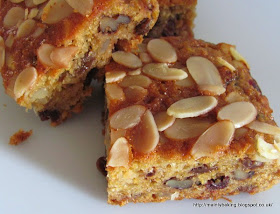I used this recipe from Proud Italian Cook, as the tart filling seemed particularly easy compared to some I'd found, and I liked the idea of using Amaretti crumbs in the base. I bought a 250g pack of crunchy Amaretti biscuits and used all but the 4 I tried for quality control purposes (!) in the base. I used 125g melted butter, as I would for other biscuit crumb bases, then followed the recipe exactly as written for the filling and cooking instructions.
 Once chilled I gave the tart some festive decoration with crystallised lemon zest chopped really finely and some sugar snowflakes. The decoration was meant to form a large star on top of the tart, but this was a little ill-defined, as I couldn't lay the stencil directly on top of the tart because it was too delicate and stuck to anything that touched it, even briefly. I found that out when I tried to cover it with cling-film, which was the reason I needed the decoration in the centre of the tart - I'd originally intended to add a border of the decorations.
Once chilled I gave the tart some festive decoration with crystallised lemon zest chopped really finely and some sugar snowflakes. The decoration was meant to form a large star on top of the tart, but this was a little ill-defined, as I couldn't lay the stencil directly on top of the tart because it was too delicate and stuck to anything that touched it, even briefly. I found that out when I tried to cover it with cling-film, which was the reason I needed the decoration in the centre of the tart - I'd originally intended to add a border of the decorations.The tart filling was wonderful - soft, creamy and quite delicious - almost like lemon curd straight from the jar. I usually prefer my lemon tarts to be sharper than was the case here, but the balance of the lemon flavour and the creamy texture, against the almost bitter Amaretti biscuits in the crunchy crumb crust was just right.
I'm not sure how much extra flavour the limoncello added, compared to using more lemon juice; and I'm not sure if the alcohol would have cooked out in such a short baking time, but I'll definitely be using this part of the recipe again.
Unfortunately, although the crumb crust tasted good, the crumbs hadn't absorbed all the butter and a lot had leaked out during cooking. It also made the texture of the crust a little greasy, although this wasn't bad enough to spoil the overall experience. I think in future I might try using part Amaretti biscuits and part a more absorbent biscuit such as digestives or oat biscuits, and also cutting down on the butter a little. It would also be a good filling to use with a pastry or almond shortbread crust.
The second of my Christmas desserts isn't worth a separate post, as I wasn't able to get any good photographs. I made a pavlova case which I filled with some of this olive-oil based chocolate mousse, then topped with a half quantity of the chestnut and ricotta cream from this Dan Lepard recipe. I was trying to make a more chocolatey, but smaller, version of Dan's Mont Blanc Gateau, and although it was delicious, it failed miserably in the looks department. I filled the pavlova case just before serving, and with hindsight, I should have used a piping bag for the chestnut cream. As there was no natural light by that time, it wouldn't have improved the photographs, but it might have made the dish little more presentable. The pavlova was a little overbaked too, so was pale brown instead of snowy white.
















































